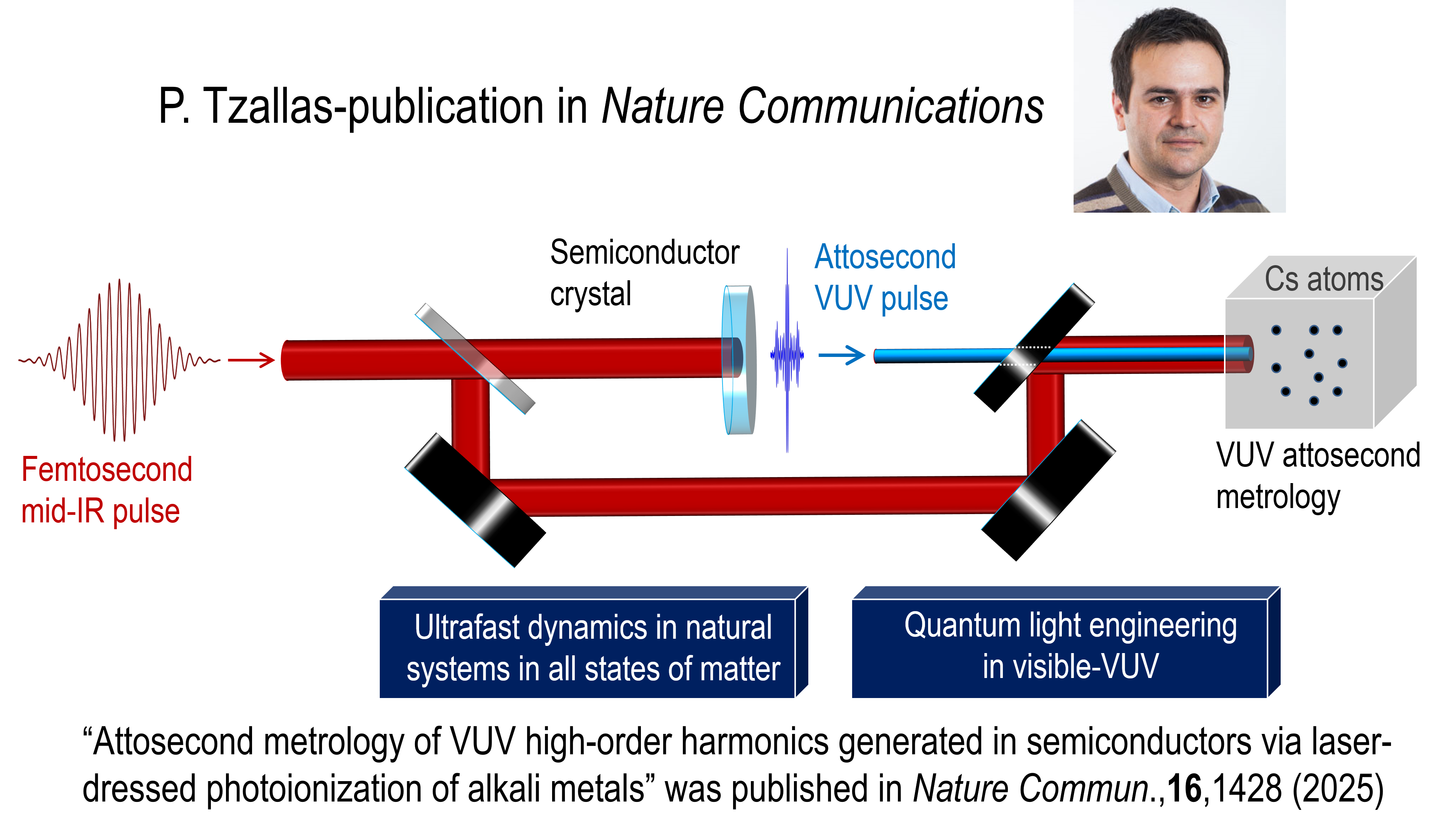
“Attosecond metrology of VUV high-order harmonics generated in semiconductors via laser-dressed photoionization of alkali metals” was published in Nature Commun.
In an experimental and theoretical study published in Nature Commun.,16,1428 (2025), an international team of researchers from ELI-ALPS (Szeged, Hungary), ICFO (Barcelona, Spain) Guangdong Technion-Israel Institute of Technology (Guangdong, China), Technische Universität Wien (Vienna, Austria), Université de Bordeaux–CNRS–CEA (Bordeaux, France), and the Institute of Electronic structure and Laser at Foundation for Research and Technology-Hellas (IESL-FORTH), have demonstrated a scheme capable of generating and characterizing VUV attosecond pulses generated by laser driven semiconductor crystals. The study opens new spectral windows for attosecond science, enabling studies of bound-state dynamics in natural systems, while facilitating the generation of quantum light in the visible-VUV.
https://doi.org/10.1038/s41467-025-56759-0
Vacuum-ultraviolet attosecond pulses for tracing ultrafast processes of natural systems
A team of researchers has presented a new technique in Nature Communications capable of generating and characterizing vacuum-ultraviolet attosecond (10-18 seconds) light pulses using laser driven semiconductors. With these pulses, the study of ultrafast dynamics in natural systems in all states of matter becomes possible.
Electrons in atoms interact with each other and with other particles, changing their motion, energies, and other features at incredibly fast timescales, on the order of attoseconds (10-18 seconds). Capturing these ultrafast changes demands ultrafast light pulses. The pulse’s duration needs to be more or less the same as the effect’s; otherwise, it would be like trying to capture a hummingbird’s wing motion with a slow, long-exposure camera.
At the end of the XIXth century, physicists thought that only femtosecond pulses (10-15 seconds) were technically possible. That started to change in the late 1980s, when physicists linked high harmonic generation with attoscience. High harmonic generation (HHG) is a process that up converts low-frequency photons to higher frequencies, and what these researchers showed was that, when multiple harmonics are emitted, they can combine to form an attosecond pulse of light —something that was finally realized in 2001.
Attosecond science was born by generating and then employing extreme-ultraviolet (XUV) pulses, and as a consequence the methods developed to detect and characterize them focused in this frequency range. More than 20 years later, the creation of attosecond pulses to perform attoscience tasks remains XUV centered. Despite the many advances that XUV attosecond pulses have provided, they also pose a challenge. Most atoms, when hit by such an energetic light source, loose one or more electrons and become positively charged — a process known as ionization. But many worth studying processes in nature occur with non-ionized atoms, which remain in the so-called bound states. Since XUV light does not provide access to the bound states of the natural systems, their study has remained out of reach for attoscience. To address this, a source delivering less energetic attosecond pulses (for instance, in the vacuum-ultraviolet spectral range) and new methods to measure their main features (duration, intensity, etc.) are needed.
This has now been done by an international team of from ELI-ALPS (Szeged, Hungary), ICFO (Barcelona, Spain) Guangdong Technion-Israel Institute of Technology (Guangdong, China), Technische Universität Wien (Vienna, Austria), Université de Bordeaux–CNRS–CEA (Bordeaux, France), and the Institute of Electronic structure and Laser at Foundation for Research and Technology-Hellas (IESL-FORTH). For the first time, the team has demonstrated that semiconductors illuminated by strong mid-infrared laser light emit vacuum-ultraviolet (VUV) attosecond pulses, has retrieved the pulses’ temporal shape and has measured their total duration. These unprecedented results, published in Nature Communications [1], establish the basis of a novel technique for probing the ultrafast changes that occur in most natural systems, preserving their bound state rather than inducing their ionization.
These new tools and methodology could be used for conducting studies in natural systems, investigating their ultrafast dynamics and even possibly using them to engineer novel quantum light states.
Reference:
[1] A. Nayak, D. Rajak, B. Farkas, C. Granados, P. Stammer, J. Rivera-Dean, Th. Lamprou, K. Varju, Y. Mairesse, M. F. Ciappina, M. Lewenstein and P. Tzallas, Nature Commun., 16, 1428 (2025). (https://doi.org/10.1038/s41467-025-56759-0).


